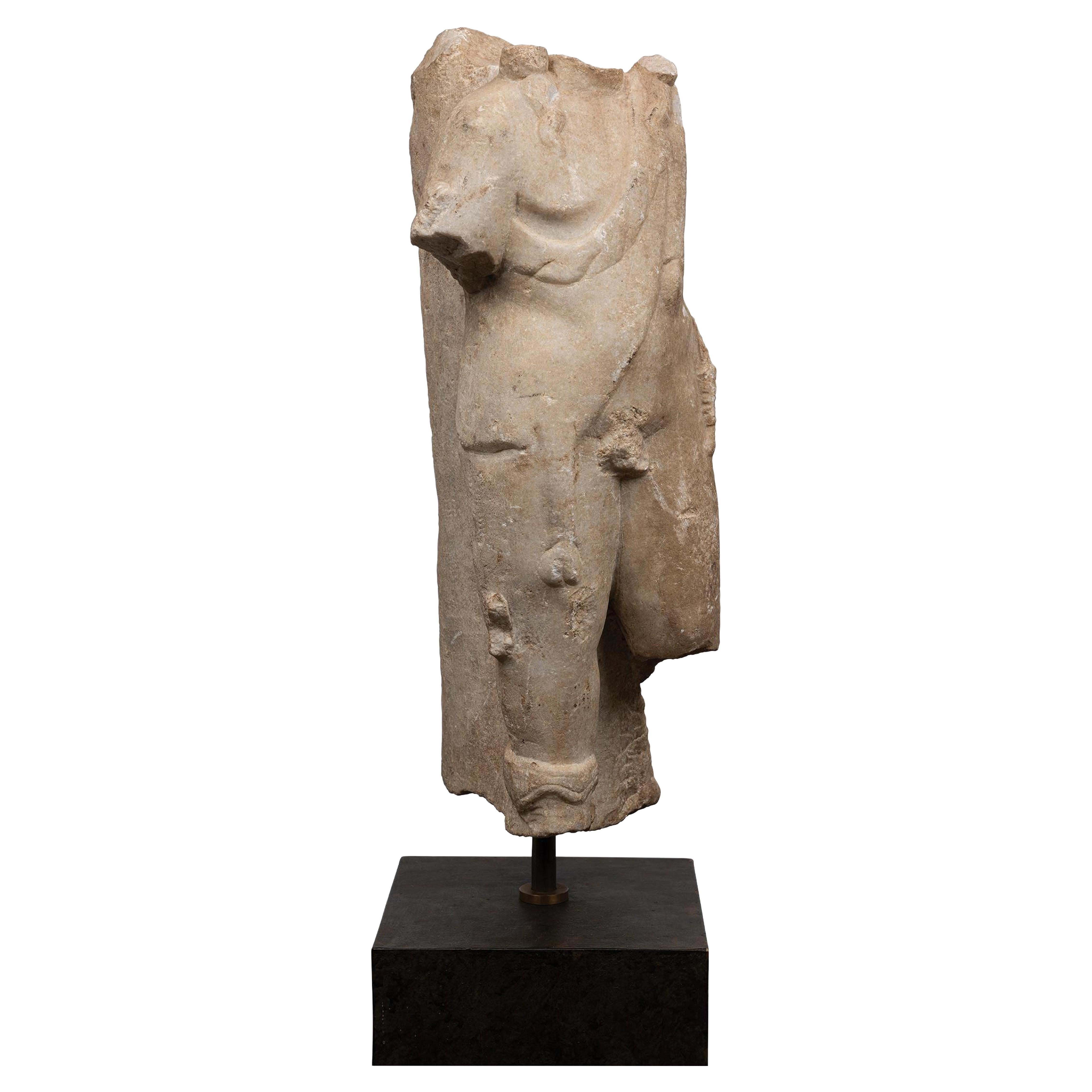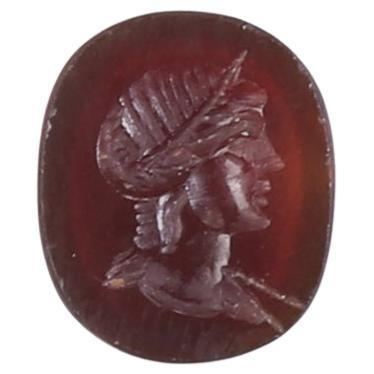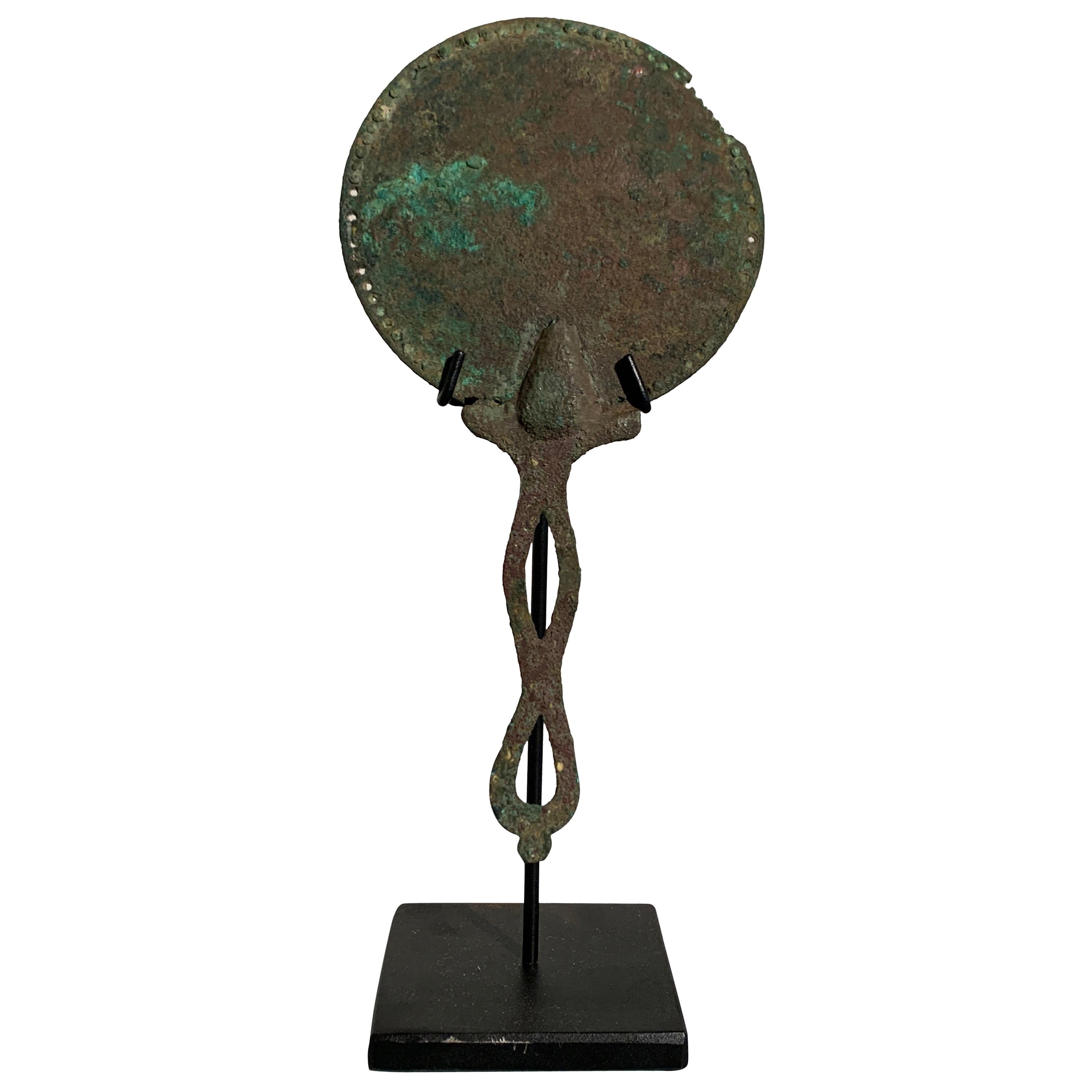Items Similar to Roman Marble Trapezophorus circa 1st-2nd Century A.D
Want more images or videos?
Request additional images or videos from the seller
1 of 18
Roman Marble Trapezophorus circa 1st-2nd Century A.D
About the Item
A Roman marble trapezophorus in the Form of a Barbarian Dacian young figure.
Circa 1st-2nd century A.D.
Measure: height 24 1/4 inches (62 cm).
Property from Mr. Radu Moldovan, Skokie, Illinois
Provenance:
B.C. Holland Gallery, Chicago, Illinois.
Jonathan Piser, Chicago, Illinois and Mexico, acquired from the above in the 1970s.
Standing with his left leg crossed over the right, and his hands bound before him, and wearing boots, leggings, short tunic bound with a belt, and mantle falling over the back, no restorations.
It is worth noting the high social position of this young man, since he has a gathered tunic with 2 brooches on each side of the shoulder. The position that the figure acquires is "a dignified position" in comparison with other captives in a submissive position.
He has the same position as:Barbarian prisoner Thusnelda, Loggia dei Lanzi, Florence
Early 2nd cent. AD
Discovered in Rome, in 1541 already part of the Capranica della Valle collection in Rome. From 1584 at the Villa Medici in Rome, in Florence since 1787. In the Loggia since 1789.
The inspiration for this sculpture likely comes from the series of bound Dacian captives that decorated Trajan's Forum. The campaign took nearly 50,000 Dacians as slaves and was commemorated on a triumphal column. There the Dacians are depicted in submission and serve as a symbol of Rome's expansion and imperial power.
The last king of Dacia, Decebalus, was a long-standing foe of Rome. In 101 A.D., Emperor Trajan led a major campaign in person to conquer the region. Trajan's engineers constructed an impressive timber bridge over the Danube and the Emperor led his troops into Dacia quickly defeating Decebalus' army. The two sides signed a peace treaty, but Decebalus couldn't resist continuing to raid Roman territory. Soon war broke out again. The Dacians fought vigorously, but Trajan brought overwhelming force to bare employing no fewer than 13 legions. The Romans ground forward inexorable into Dacia eventually capturing the capital city. Decebalus fled with the Roman cavalry in hot pursuit. Finally, with Roman troopers closing in and his bodyguards slain, Decebalus took his own life.
With the death of Decebalus in 106 A.D., the Dacian Wars ended, and the Kingdom of Dacia was annexed and turned into a Roman province. These foreign conflicts resulted in changes to the physical landscape of Rome itself. Dacia was a region with abundant mineral resources and when Rome annexed it, they also took control of especially rich gold and silver mines. Ancient historians claim Trajan acquired nearly 550 tons of gold and silver from Decebalus' treasury. Much of this staggering wealth was expended on spectacular building projects in Rome, the centerpiece of which was Trajan's Forum.
Catalogue note
For a related figure in the Museum of Fine Arts Boston see: Christie's, London, October 24th, 2013, no. 74.
- Creator:Europa Antiques (Artist)
- Dimensions:Height: 24.41 in (62 cm)Diameter: 9.06 in (23 cm)
- Style:Classical Roman (Of the Period)
- Materials and Techniques:
- Place of Origin:
- Period:
- Date of Manufacture:1st-2nd Century A.D.
- Condition:Wear consistent with age and use.
- Seller Location:Madrid, ES
- Reference Number:1stDibs: LU5779231828162
About the Seller
4.9
Platinum Seller
These expertly vetted sellers are 1stDibs' most experienced sellers and are rated highest by our customers.
Established in 2005
1stDibs seller since 2021
222 sales on 1stDibs
Typical response time: <1 hour
- ShippingRetrieving quote...Ships From: Madrid, Spain
- Return PolicyA return for this item may be initiated within 14 days of delivery.
More From This SellerView All
- Important Roman "Torso"in Carrara Marble early 20th CenturyBy Europa AntiquesLocated in Madrid, ESImportant Roman "Torso" in Carrara marble early 20th Century Carrara marble Torso h: 32cm. 24cm x 16cm Base: 20cm x 20cm h: 20cm ( modern base ) H.total: 62cm 30kg Excellent condi...Category
Early 20th Century Italian Classical Roman Figurative Sculptures
MaterialsCarrara Marble
- Roman Relief "Warrior" late 19th Century in Carrara Marble With VideoBy Europa AntiquesLocated in Madrid, ESRoman Relief "Warrior" late 19th Century in Carrara Marble Italy 45cm x 19cm good condition for the timeCategory
Antique Late 19th Century Italian Classical Roman Figurative Sculptures
MaterialsCarrara Marble
- 12th Century Italian Roman Marble LionBy Europa AntiquesLocated in Madrid, ESItalian Romanesque 12th century marble recumbent lion 12th century Italian roman marble lion with a stylized mane and tail wrapped around its body a...Category
Antique 15th Century and Earlier Italian Gothic Animal Sculptures
MaterialsStone
- CARRARA MARBLE ROMAN TORSO 19th CenturyBy Europa AntiquesLocated in Madrid, ESCarrara MARBLE ROMAN TORSO 19th century HEIGHT 54cm MAXIMUM HEIGHT 70cm WIDTH 30cm DEPTH 20cm OVERALL WEIGHT 56 Kg BASE HEIGHT INCLUDED 70 cm Material White carrara marble Base in N...Category
Antique Late 19th Century Italian Baroque Busts
MaterialsCarrara Marble
- Original 18th Century Roman Marble Lion BathBy Europa AntiquesLocated in Madrid, ESOriginal 18th Century Roman Marble Lion Bath It has the Lions head to the front, rings either side,with a beautifully veined patina These ...Category
Antique 18th Century Italian Baroque Figurative Sculptures
MaterialsMarble
- Female Bust, Roman Venus in Black Marble, Early 20th CenturyBy Europa AntiquesLocated in Madrid, ESFemale bust, Roman venus in black marble early 20th century Capitoline Venus. Italy Academic copy Hispanic black marquinia marble. Bust height 66 cm ...Category
Early 20th Century Italian Modern Figurative Sculptures
MaterialsMarble
You May Also Like
- A Roman Marble Sculpture of Hercules, Circa 1st / 2nd Century ADLocated in ARMADALE, VICA Roman Marble Sculpture of Hercules, Circa 1st / 2nd Century AD The sculpture is nude except for the draped Nemean lion skin. Provenance: Sotheby's London, December 14, 1981, lot ...Category
Antique 15th Century and Earlier European Classical Roman Figurative Scu...
MaterialsMarble
- Roman Column, 1st Century A.D, SpainLocated in Girona, SpainRoman column. Made with marble. 1st Century A.D, Spain Very decorative. Good Condition. With certificate of authenticity. Provenance: Caldes de Mont Bui N...Category
Antique 15th Century and Earlier Spanish Classical Roman Figurative Scul...
MaterialsMarble
- Roman Antique Marble Sculpture, 2nd Century Ad, South of FranceLocated in Girona, SpainRoman Antique marble sculpture, 2nd century AD, South of France. This sculpture is a Roman Antiquity. Frontal section of a Roman Sarcophagus. Made...Category
Antique 15th Century and Earlier French Classical Roman Mounted Objects
MaterialsMarble, Iron
- Small Hellenistic Parthian Marble Head of a Man, circa 2nd to 1st Century BCLocated in Austin, TXA small carved marble head of a man, Parthian Empire, Hellenistic Period, circa 2nd to 1st century BC, modern day Iran. The small marble head car...Category
Antique 15th Century and Earlier Persian Hellenistic Busts
MaterialsMarble
- Ancient Roman Intaglio from 1st-2nd Century AD Carved Carnelian StoneLocated in Chicago, ILAncient Roman Carnelian Intaglio. An intaglio is defined as a small Gemstone, generally semi-precious, that has been carved with images or inscriptions only on the face. This style of carving is the opposite of the cameo technique. The engraving of gemstones was a major luxury art form in the ancient world and an important one in some later periods. This particular Intaglio is Carnelian and dates from the second century AD and shows the head of a figure in profile. It is in very nice original condition and would be ideal for making into a ring. The word Intaglio comes from the Italian word intagliare, meaning “to engrave” or “cut into.” Intaglio describes the process in which an image is engraved into a stone, creating an image in the negative. When a stone carved in this way is pressed into hot wax...Category
Antique 15th Century and Earlier Italian Classical Roman Antiquities
MaterialsCarnelian, Stone
- Roman Bronze Hand Mirror with Beautiful Patina, circa 1st CenturyLocated in Austin, TXA simple and elegant Roman bronze hand mirror, late Republic Period, circa 1st century, Italy. The bronze mirror of simple form. The round face with a pierced border design. The openwork handle...Category
Antique 15th Century and Earlier Italian Classical Roman Antiquities
MaterialsBronze





